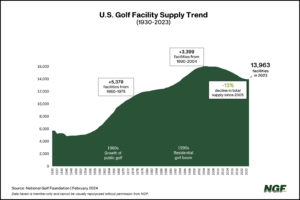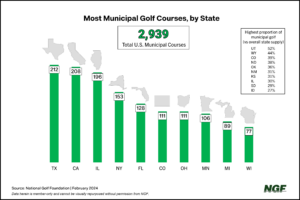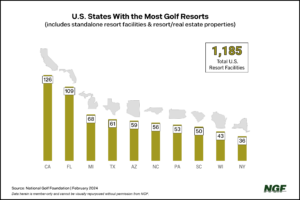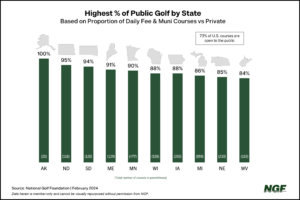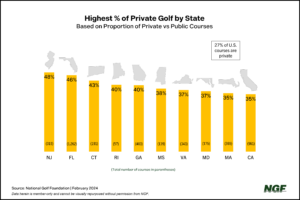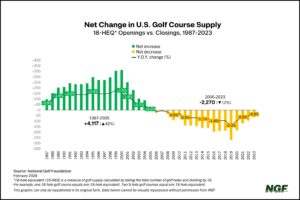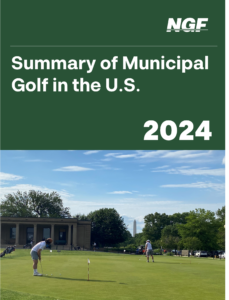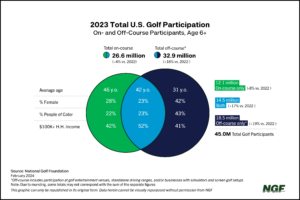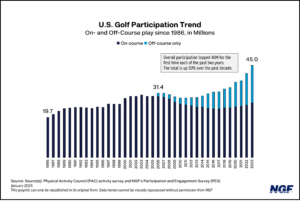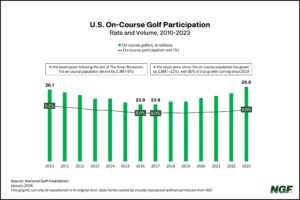Search Results
There have been two significant periods of growth in U.S. golf supply since the Roaring Twenties: the democratization of golf in the 1960s and the 1990s Golf Boom fueled by real estate development and entrepreneurs trying to cash in on golf. There have also been two sustained contractions in supply, the first coinciding with The Great Depression, as the number of U.S. golf facilities declined by 15% between 1930 and 1946, and the second beginning in 2006, following the implosion of the real estate market and supercharged by The Great Recession. The number of U.S. golf facilities has declined by 13% over …
Read MoreWith more than 2,900 municipal golf courses at over 2,500 facilities nationwide, the U.S. market is close to the all-time highs in both categories. States with some of the biggest cities (and municipal golf operators) — Dallas, Los Angeles, Chicago and New York — have the most muni courses overall. But its Utah that has the highest proportion of municipal courses relative to its total supply, with government-owned or operated properties accounting for 67 of its 130 courses.
Read MoreThere are more than 1,185 golf resort facilities in the U.S., two-thirds of which are standalone properties without a real estate component. Rhode Island is the only state without a golf resort open to traveling golfers, while large, all-season destination states like California and Florida each have more than 100 in total. The accompanying graphic shows the states that rank in the Top 10 in total resort supply, which also generally tracks with overall golf supply.
Read MoreAlmost three-quarters of overall golf supply, whether facilities or courses, is open to public play. These 10 U.S. states have the highest proportion of public courses to private clubs. Alaska leads the way, as there are no private courses at all in the nation's largest, yet third least-populated, state. Great Lakes states such as Michigan, Minnesota and Wisconsin are among the best-supplied states with the greatest proportion of public access golf. Michigan actually has the most public golf courses of any state in the country.
Read MoreJust over one-quarter of U.S. golf facilities are private, with the majority open to public play. New Jersey, the most densely populated state in the nation, has the highest proportion of private golf relative to total supply, with half the golf facilities in the Garden State — from Baltusrol to Pine Valley, — being member-only private clubs. Three of the country's smallest five states by land mass (New Jersey, Connecticut and Rhode Island) rank among the top five with the highest proportion of private golf. Florida, with its wealth of private clubs in the southern part of the state, …
Read MoreGolf course closures last year came in at their lowest figure in almost two decades, resulting in less than a 1% reduction in overall U.S. supply. Here’s a bit more context, as the closure of golf courses is a topic of frequent interest… and frequent misinterpretation.
Read MoreMunicipal one-pager
Read MoreThe number of on-course golfers has now increased for six straight years, but also notable is that the demographic makeup of the base is changing — albeit gradually in a sport with over 26 million Americans who play recreationally.
Read MoreGolf participation started to increase significantly in the 1990s and early 2000s amid the U.S. course development boom, as the industry added over 3,000 new facilities over a 20-year span from 1986 to 2005. While on-course participation dipped after its peak in 2003, there has been an upswing in recent years, along with a dramatic increase in the number of participants who only play off-course forms of the game.
Read MoreAssessing the state of the golf industry in 2023 reveals increases in participation and play, a healthier balance between the number of golfers and courses, and an evolution of a traditional game that’s positively affecting golf demand. Read more…
Read More




